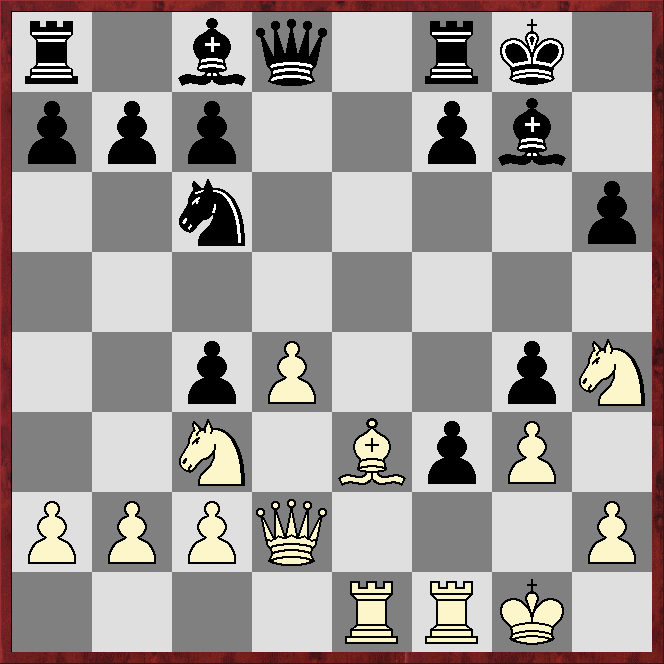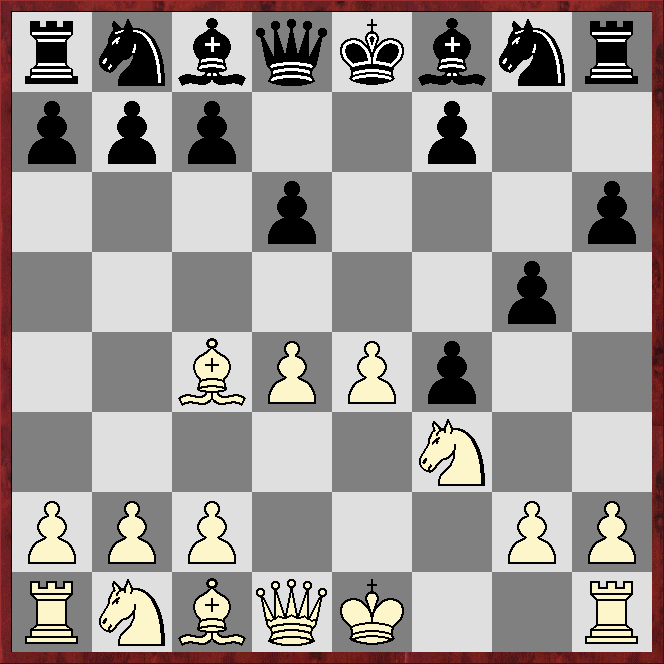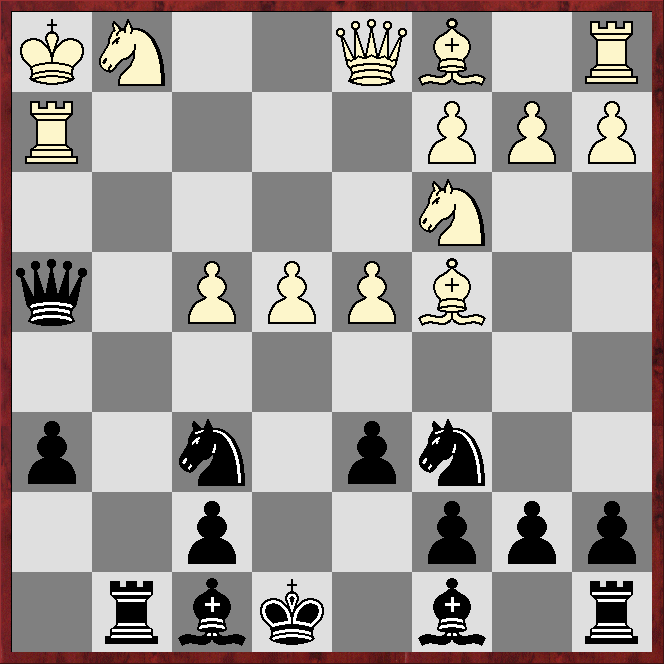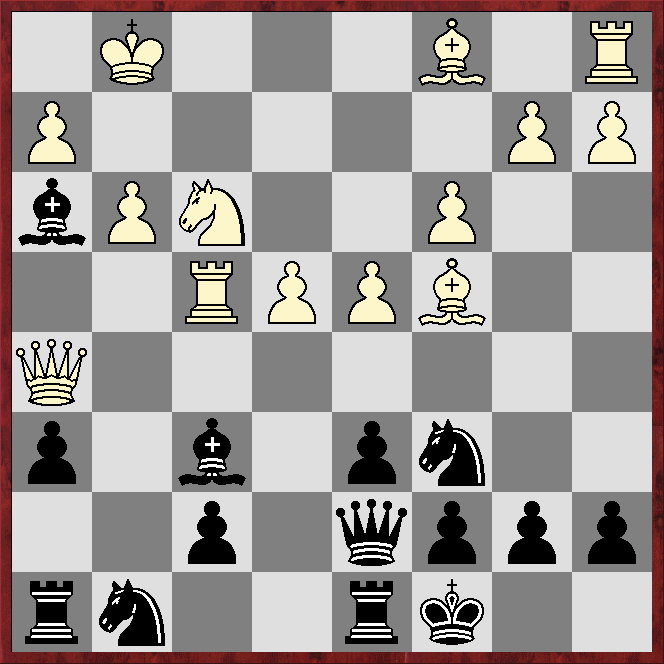Fischer's Bust of 1961 did not put him off playing the opening - indeed, including simultaneous exhibitions, Spassky was still playing the King's Gambit 45 years later, when he scored +5=1-0 at a 2006 San Francisco simul.
Overall, eight opponents tried Fischer's recommended 3...d6, including four at one Reno simul in 2004.
Presumably those players had prepared the 'refutation' between themselves, but if so it did them no good - they all lost, including one game ending in checkmate on move 12.
At a more serious level Spassky first faced 3...d6 in the Hungary-Russia match of 1967.
Spassky - Lajos Portisch
1.e4 e5 2.f4 exf4 3.Nf3 d6 4.Bc4 h6 5.d4 g5
*****
*****
*****
*****
6.g3!?
Seeking to undermine the black kingside pawn-chain.
*****
*****
*****
*****
6...Nc6!?
6...Nc6!?
The most popular continuation in ChessBase's 2023 Mega database is 6...g4 7.Nh4 f3, although Stockfish16 and Komodo14.1 reckon Harmen Jonkman's 8.Nc3 comes close to equalising (the engines do not approve of the King's Gambit). Alexander Beliavsky played 6...fxg3 in beating a 2215 in 1978, but the engines like that even less. They agree with Portisch's choice, but also like Larry Evans' 6...Bg7 (played in a US Open before Fischer wrote his Bust, the position being reached by a different move-order).
7.gxf4?!
A strange move for a grandmaster to make. Did Spassky really miss Portisch's reply? Probably not, but maybe he misjudged the strength of it. The position is anyway difficult for White, eg 7.0-0 transposes to a relatively well-known position where White scores very poorly. Perhaps best is the engines' 7.Nc3.
7...g4 8.Ng1 Qh4+ 9.Kf1 Nf6 10.Nc3 g3 11.Kg2?!
The engines reckon 11.Qe2 and 11.Qd2!? are much better.
11...gxh2 12.Rxh2 Rg8+ 13.Kh1
*****
*****
*****
*****
13...Qxh2+!?
Black has a large advantage after this, according to the engines, but they reckon even stronger is 13...Qg3!? with the simple threat of ...Ng4. After 14.Be2 Black can switch to 14...Bg4, again with ...Ng4 to come.
14.Kxh2 Ng4+ 15.Qxg4
The queen is doomed anyway. But after ...
15...Bxg4
... White has no compensation for the exchange. However Spassky gradually outplayed Portisch, winning the bishop-pair and slowly improving his position, eventually gaining the full point. Nevertheless the opening was a success for the 'refutation'.
Seven years later Spassky again faced the Bust.
Spassky - Axel Ornstein
Soviet Union - Sweden, Olympiad (Nice, France) 1974
1.e4 e5 2.f4 exf4 3.Nf3 d6 4.Bc4 h6 5.d4 g5 6.0-0
This is easily the main move in Mega23, although it is not liked by the engines.
6...Bg7 7.c3 Nc6 8.g3
Again Spassky seeks to undermine the black kingside pawn-chain, but the engines are not impressed. Stockfish16 suggests Steinitz's 8.Qb3!?, while Komodo14.1 likes 8.Qa4!?, which goes back to an 1839 simul by Alexander McDonnell.
8...g4?!
The wrong idea, according to the engines, which much prefer 8...fxg3 and 8...Bh3.
9.Nh4 f3
 |
| Black is a protected passed-pawn up, but the white king is much safer than in the previous game |
*****
*****
*****
*****
10.Nd2 Bf6 11.Ndxf3!?
All four games in Mega23 to reach the position saw this capture, but the engines reckon much stronger is 11.Nhxf3!?, which is counterintuitive since the king's knight is nearer the black king, and the queen's knight obstructs the queen's bishop. After 11.Nhxf3!? the engines reckon best play runs 11...gxf3 12.Qxf3 Bh3 13.Rf2 Qd7 14.e5, which frees the e4 square for the white queen's knight. Black can prevent it getting there with 14...Bg4, when best seems to be 15.Qe4. Black is then forced to play 15...dxe5, after which the engines give 16.Nb3!? with what they reckon is strong compensation for a knight.
11...gxf3 12.Qxf3 Bh3 13.Qh5!?
Also possible, as in the previous note, is 13.Rf2. But on 13...Qd7 the continuation 14.e5?! no longer has much point as Ne4 is not threatened.
13...Qd7 14.Rf4 0-0-0 15.Nf3?!
Probably better is 15.Nf5.
*****
*****
*****
*****
15...Ne5!
Giving back the knight in order to engineer exchanges and emerge the exchange up.
16.dxe5 dxe5 17.Rf5 Bxf5 18.Qxf5
Not 18.exf5? as 18...Qd1+ gives Black a very strong attack.
18...Qxf5 19.exf5
 |
| Spassky has even less compensation for the exchange than in the previous game, but battled on and salvaged a half-point when Ornstein missed a winning continuation on move 71 |
Next up with the Bust was reigning world champion Anatoly Karpov in the final of a made-for-TV tournament.
Spassky (2625) - Karpov (2720)
'World Cup' (Hamburg) 1982
1.e4 e5 2.f4 exf4 3.Nf3 d6 4.Bc4 h6 5.d4 g5 6.0-0 Bg7 7.g3!?
Not bothering with the the centre-strengthening 7.c3 and instead accelerating his kingside counterplay, but again the engines are unimpressed.
7...g4?!
And again the engines reckon this is the wrong idea, claiming Black has at least the upper hand after 7...Bh3 or 7...Nc6.
8.Nh4 f3 9.Nc3!?
Spassky tries to use the absence of c3 to speed his development. Previous games to reach the position, going back to 1850, saw 9.c3.
9...Nc6 10.Be3 Nf6 11.Qd2 Nxe4!? 12.Nxe4 d5 13.Nc3 dxc4 14.Rae1 0-0
 |
| Now both players have castled - a far-from-common occurrence in these lines - how would you assess the position? |
*****
*****
*****
*****
Black is two pawns up, for the moment, and has a protected passed pawn, but also has doubled pawns. Black also has the bishop-pair, but White has a lead in development and the safer-looking king. The engines reckon the position is completely equal.
15.Ne5 Ne7 16.Bxh6 Ng6 17.Nxg6 fxg6 18.Bxg7 Kxg7 19.Qd4+ Qf6 20.Re7+ Kg8 21.Qxf6 Rxf6 22.Rxc7 Bf5 23.Rxc4 Rxe8
CONCLUSIONS
These games seem to show five things.
1. Fischer's Bust gives Black an edge. But whether that counts as a refutation depends on whether Black gaining an advantage in the opening 'refutes' White's play or is merely good news for Black.
2. Modern engines are not just critical of common individual moves, but dislike plans that have become well-established over the years.
3. Play is very complicated with much needing to be considered both tactically and positionally.
4. The player more familiar with the arising positions will probably have a considerable practical advantage.
5. Much remains to be learned about what has become known as the Fischer Variation of King's Gambit, but that may also be true of the King's Gambit as a whole.





No comments:
Post a Comment